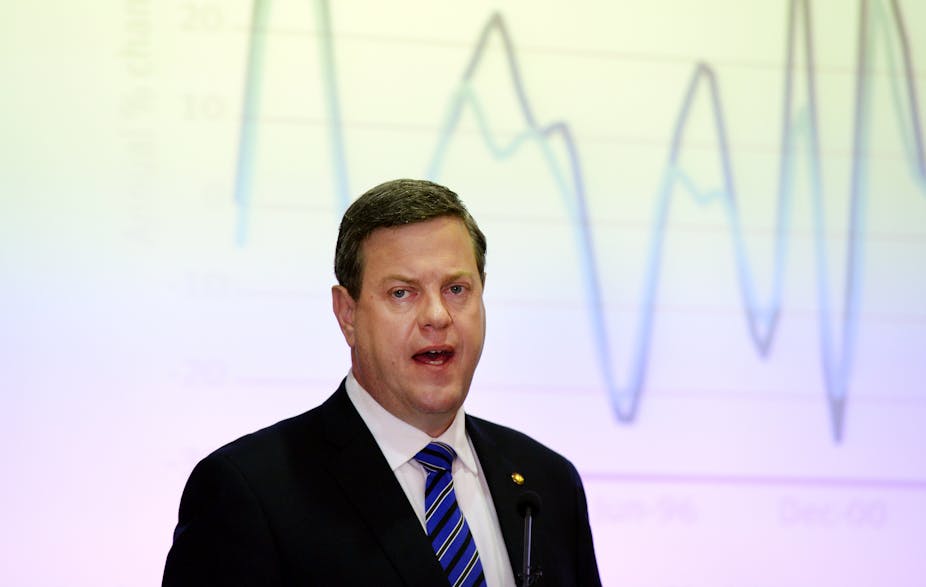As Queensland Treasurer Tim Nicholls released the state budget yesterday, one could be excused for not really noticing. Long the poor cousin of Australian Federalism, state budgets rarely get much press – and rightly so.
The headline announcement was, of course, privatisations of more than A$33 billion in state assets. This, of course, has little consequence for state finances, as the sale of assets precludes future income streams for those assets. If anything, the higher borrowing costs and equity returns expected by the private sector, and the transaction fees involved in the sales of those assets, will make privatisations a negative net contributor to the state’s financial health – but that is another story.
Dig a little deeper, and things become positively soporific. Like a household budget slightly out of balance, money comes in (in the form of state taxes and mostly GST) and money goes out. The Queensland government does the things it has to do – policing, courts, housing and public works. Mostly, though, it does two things – it provides health services through public hospitals and it provides schooling through state schools.
Taken together, health and education equate to 53.9% of expenditures in 2012-13, rising to 54.5% in the 2013-14 year. Health and education’s share of expenses is gradually rising, not necessarily in response to any new political priorities, but rather in response to the grinding certainties of an ageing population, better health technologies and patient expectations, and increasing numbers of school-aged children.
Big on promise…
The current LNP government was elected in a landslide on March 24, 2012. The Labor Party was all but wiped out, reduced to a team of seven parliamentarians in a parliament of eighty nine. Clearly on the nose with voters, the outgoing government had been branded financial profligates by the incoming one – and yet little, in effect, has changed, in an absolute or relative sense, about how the money is spent.
Of course there have been retrenchments of public servants across the departments, and yet employee numbers are increasing again. This, of course, is as it should be, as there is real work to be done. One area where employment numbers have not budged is in the ranks of the government’s ministers. The last Bligh government had 18 ministers and 13 parliamentary secretaries, while the Newman Cabinet has 19 ministers and 12 assistant ministers – all of course with a coterie of media and policy advisers, drivers and assistants.
However, the real business of government goes on, and even as assets are sold and debts are paid off, the share of government expenses for various key departmental activities remains relatively steady – health increasing from $10.55 billion under Labor in 2010-11 to $12.33 billion under the LNP in 2013-14, police increasing from $1.8 under Labor to $2.0 billion under the LNP, education increasing from $7.58 billion to $8.67 billion (albeit with the addition of employment) – and the list goes on.
All this begs the question – what real purpose will the political apparatus of the states actually contribute in 2014? If they won’t, or can’t, do much in terms of how money is spent, what is the point?
The states’ roles have been in retreat since Federation – indeed every major High Court decision to assess the relative prerogative of the State and Commonwealth over the last 113 years has shifted power towards Canberra. The states now do only what Canberra does not want to do – and they do it with dwindling resources and a lack of capacity to make sensible plans in relation to future revenues and expenses.
Lumped with health and education
The recent federal budget showed as much – with the Commonwealth retreating from funding the Gonski reforms, leaving the states in the invidious position of having to argue for an increase to the GST to fund basic education, health and policing.
As a nation, we must do better. The federation is broken, and it has been broken for a long time. The most sensible answer is to start again, by abolishing the states entirely. The states, of course, are colonial relics, parochial lines on a map that have little social or economic relevance today. Developed at a time before telecommunications and decent transportation, today they could not be more anachronistic.
Increasingly, our challenges and opportunities are national. Our Asia-Pacific neighbours sensibly pay little attention to state boundaries when they consider our role and our future.
As the resource booms tapers and the challenges to public finances, state and federal, become more acute, Australians should ask again – are we citizens of Australia first, or residents of its states. If the former, why do we persist with the latter?

